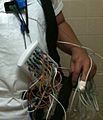Dementia with Lewy bodies facts for kids
Dementia with Lewy bodies (DLB) is a type of dementia. It affects how a person thinks, moves, sleeps, and behaves. It can also impact automatic body functions, like heart rate or digestion. DLB is caused by tiny clumps of protein called Lewy bodies that build up inside brain cells. These clumps are made of proteins like alpha-synuclein and ubiquitin. Scientists can see these Lewy bodies when they study brain tissue after a person has passed away.
DLB is a common type of dementia. It affects many people around the world. For example, in the United States, about 1.3 million people have this condition.
Contents
What Are Lewy Bodies?
Lewy bodies are tiny, abnormal clumps of protein. They form inside the brain's nerve cells, called neurons. Think of them like tiny, unwanted balls of yarn that get tangled up. These clumps are mostly made of a protein called alpha-synuclein. Another protein, ubiquitin, is also found in them.
When these Lewy bodies build up, they stop brain cells from working properly. This can lead to problems with memory, thinking, and movement. They are named after Dr. Frederic Lewy, who first discovered them.
How DLB Affects People
Dementia with Lewy bodies causes a mix of symptoms. These symptoms can change from day to day, or even hour to hour.
Thinking and Memory Changes
People with DLB often have problems with their thinking skills. This can include:
- Trouble paying attention or staying focused.
- Difficulty planning or solving problems.
- Changes in how they understand things.
- Memory problems, though these might not be the first or worst symptoms.
Movement Problems
DLB can cause movement issues similar to Parkinson's disease. These might include:
- Slow movements.
- Stiffness in arms and legs.
- Shaking (tremors).
- Trouble with balance, which can lead to falls.
Sleep Issues
One common symptom is a sleep disorder called REM sleep behavior disorder. This is when people act out their dreams during sleep. They might shout, punch, or kick while dreaming. This can be very vivid and sometimes dangerous.
Hallucinations and Delusions
Many people with DLB experience hallucinations. These are usually visual, meaning they see things that are not really there. For example, they might see animals, people, or objects. These hallucinations can be very detailed and real to the person experiencing them. Sometimes, people might also have delusions, which are strong beliefs that are not true.
Other Body Functions
DLB can also affect parts of the body that work automatically. These are things we don't usually think about, like:
- Blood pressure changes, leading to dizziness.
- Problems with digestion or constipation.
- Changes in body temperature.
Diagnosing DLB
Diagnosing DLB can be tricky because its symptoms can be similar to other conditions. Doctors look for a specific combination of symptoms. They also use different tests to help.
Medical History and Exams
A doctor will ask about the person's symptoms and medical history. They will also do a physical and neurological exam. This helps them check brain function, movement, and reflexes.
Brain Scans
Doctors might use brain scans to help with diagnosis.
- Positron emission tomography (PET) scans can show how the brain is working. For example, a special type of PET scan using a substance called PiB can help detect certain protein buildups in the brain.
- Other scans like MRI or CT can rule out other causes for the symptoms.
Sleep Studies
If a person has sleep problems like acting out dreams, a polysomnography (sleep study) might be done. This test monitors brain waves, breathing, and body movements during sleep.
What Causes DLB?
The exact cause of why Lewy bodies form is not fully known. Scientists believe it's a mix of different factors.
Genetics
Sometimes, genetics can play a small role. Certain changes in genes can increase the risk of developing DLB. For example, variants of a protein called apolipoprotein E can influence the risk. However, most cases of DLB do not run in families.
Brain Changes
The build-up of alpha-synuclein protein into Lewy bodies is a key feature. These protein clumps damage brain cells. This damage affects the brain's ability to send messages and work properly.
Living with DLB
There is currently no cure for DLB, but treatments can help manage the symptoms.
Medications
- Medicines can help with thinking and memory problems.
- Other medications can help with movement issues.
- Sleep medications can help with sleep disturbances.
- Sometimes, medicines are used to help with hallucinations or delusions.
Therapies and Support
- Physical therapy can help with movement and balance.
- Occupational therapy can help people with daily tasks.
- Speech therapy can help with communication or swallowing difficulties.
- Support groups for families and caregivers can provide valuable help and advice.
Living with DLB can be challenging, but understanding the condition and getting the right support can make a big difference. Researchers are always working to learn more about DLB and find new treatments.
Images for kids
-
Positron emission tomography, for example, using PiB is helpful in the diagnosis of DLB.
See also
 In Spanish: Demencia con cuerpos de Lewy para niños
In Spanish: Demencia con cuerpos de Lewy para niños




